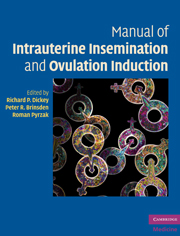Book contents
- Frontmatter
- Contents
- List of contributors
- Preface
- 1 An overview of intrauterine insemination and ovulation induction
- 2 Male causes of infertility: evaluation and treatment
- 3 Female causes of infertility: evaluation and treatment
- 4 Clinic and laboratory design, personnel and equipment
- 5 Semen analysis: semen requirements for intrauterine insemination
- 6 Semen preparation for intrauterine insemination
- 7 Ovulation induction for intrauterine insemination I: oral drugs clomiphene, tamoxifen, letrozole
- 8 Ovulation induction for intrauterine insemination II: gonadotropins and oral drug–gonadotropin combinations
- 9 Ultrasonography in the management of ovulation induction and intrauterine insemination
- 10 Insemination technique and insemination complications
- 11 Cryopreservation
- 12 Donor sperm
- 13 The role of the nurse in intrauterine insemination and ovulation induction
- 14 Complications of ovulation induction I: high-order multiple births, miscarriage, ectopic pregnancy, congenital anomalies, ovarian cancer
- 15 Complications of ovulation induction II: ovarian hyperstimulation syndrome, ovarian torsion
- 16 The psychological issues of intrauterine insemination
- 17 Ethical, legal and religious considerations of artificial insemination
- Index
7 - Ovulation induction for intrauterine insemination I: oral drugs clomiphene, tamoxifen, letrozole
Published online by Cambridge University Press: 01 February 2010
- Frontmatter
- Contents
- List of contributors
- Preface
- 1 An overview of intrauterine insemination and ovulation induction
- 2 Male causes of infertility: evaluation and treatment
- 3 Female causes of infertility: evaluation and treatment
- 4 Clinic and laboratory design, personnel and equipment
- 5 Semen analysis: semen requirements for intrauterine insemination
- 6 Semen preparation for intrauterine insemination
- 7 Ovulation induction for intrauterine insemination I: oral drugs clomiphene, tamoxifen, letrozole
- 8 Ovulation induction for intrauterine insemination II: gonadotropins and oral drug–gonadotropin combinations
- 9 Ultrasonography in the management of ovulation induction and intrauterine insemination
- 10 Insemination technique and insemination complications
- 11 Cryopreservation
- 12 Donor sperm
- 13 The role of the nurse in intrauterine insemination and ovulation induction
- 14 Complications of ovulation induction I: high-order multiple births, miscarriage, ectopic pregnancy, congenital anomalies, ovarian cancer
- 15 Complications of ovulation induction II: ovarian hyperstimulation syndrome, ovarian torsion
- 16 The psychological issues of intrauterine insemination
- 17 Ethical, legal and religious considerations of artificial insemination
- Index
Summary
Introduction
Intrauterine insemination (IUI) and ovulation induction (OI) are oft en combined in order to increase the effectiveness of infertility treatment. The reason most frequently given for combining OI with IUI to treat male-factor infertility is to maximize the possibility of pregnancy by increasing the number of preovulatory follicles. However, unless the female partner is anovulatory or has luteal deficiency, there is conflicting evidence on whether oral OI drugs do increase pregnancy rates in IUI cycles. On the other hand, there is undeniable evidence that IUI does improve pregnancy rates in many cases when clomiphene citrate (CC) is used to treat ovulation dysfunction or luteal insufficiency. Whether IUI should be used in all OI cycles, or only if there is either a poor postcoital test (PCT) or semen quality below WHO standards, is arguable. At the Fertility Institute of New Orleans only 20% of 3,400 CC pregnancies have required IUI.
The advantages of oral drugs over gonadotropin for OI include a low incidence of multiple pregnancies and ovarian hyperstimulation syndrome (OHSS), low cost, oral administration and less need for cycle monitoring. However, due to its antiestrogenic nature, CC may adversely affect cervical mucus and endometrial receptivity. Tamoxifen (TMX), a structurally related selective estrogen receptor modulator (SERM) that has a weak estrogenic effect on cervical mucus and the endometrium, and letrozole (LET), an aromatase inhibitor, are used “off label” to replace CC.
Action
CC and TMX are competitive antagonists of ovarian estrogen at hypothalamic receptor sites, and exhibit either antiestrogenic activity (CC) or weak estrogenic activity (TMX) at peripheral receptor sites (Fig. 7.1).
- Type
- Chapter
- Information
- Publisher: Cambridge University PressPrint publication year: 2009

